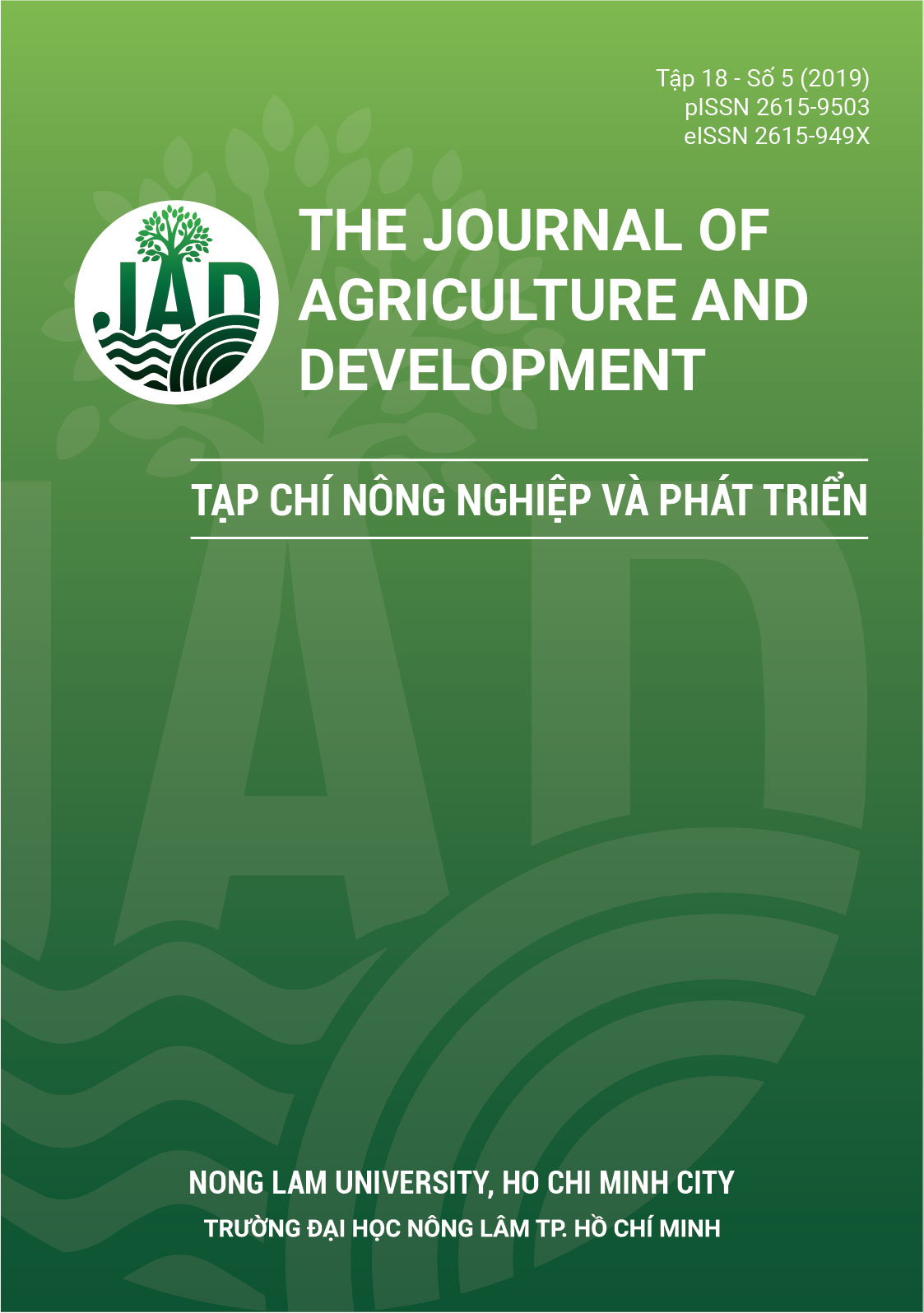Cloning, expressing and purification of recombinant C-terminal PMT of Pasteurella multocida
Main Article Content
Abstract
Pasteurella multocida strains produce heat-stable toxin Pasteurella Multocida Toxin (PMT) which is the main virulence factor causing pasteurellosis in pigs. Therefore, PMT protein is considered as a promising candidate to study recombinant vaccine against pasteurellosis in pigs. In this study, we cloned the nucleotide sequence coding C-terminal fragment of PMT (tPMT-780), from acid amine 506 to acid amine 1285, into pRSET-A vector and expressed it on Escherichia coli BL21 bacteria. The SDS-PAGE result showed that tPMT-C780 was well-expressed by IPTG 1mM induction and determined to be insoluble protein, therefore it was purified by denaturation method using Ni-NTA beads. The protein elution samples contained only one protein band similar with the size of tPMT-C780 and positively reacted with PMT-specific antibody. These results suggested that we were successful in expressing and purifying C-terminal protein of PMT toxin, tPMT-C780. This is the primary material for further studies to produce recombinant vaccine against pasteurellosis in pigs.
Article Details
References
Bui, H. Q. (1998). Characteristics of pasteurellosis in Vietnam in recent years. Veterinary Sciences and Techniques 5(1), 9-94.
Cao, H. V. (2002). Epidemiology of pasteurellosis in buffaloes, cows, and swines in Dak Lak, and some preventive and treatment measures. (Unpublished doctoral dissertation) Vietnam National University of Agriculture. Ha Noi, Vietnam.
Freddy, H., Frank, P., Koen, C., Dominiek, M., Richard, D., & Annemie, D. (2004). Efficacy of vaccines against bacterial diseases in swine. Veterinary Microbiology 100(3-4), 255-268. https://doi.org/10.1016/j.vetmic.2004.03.002
García, N., Fernández-Garayzábal, J. F., Goyache, J., Domíngue, L. & Vela, A. I. (2011). Associations between biovar and virulence factor genes in Pasteurella multocida isolates from pigs in Spain. Veterinary Record 169(14), 362-366. https://doi.org/10.1136/vr.d4869
Hoang, H. D. (2004). Study epidemiological characteristics and factors influencing pasteurellosis in buffaloes, and cows in Bac Giang (1995-2001), and suggest preventive and treatment measures. (Unpublished doctoral dissertation). Hanoi Agriculture and Forestry University, Ha Noi, Vietnam.
Hussaini, J., Abdullahi, M. A., & Ismail, S. (2012). Expression and immunogenicity determination ofrecombinant clone of Pasteurella multocida serotype B against Haemorrhagic septicaemia: Towards a vaccine development. Journal of Animal and Veterinary Advances 11(3), 351-356. https://doi.org/10.3923/javaa.2012.351.356.
Hussaini, J., Nazmul, M. H. M., Abdullah, M. A., & Ismail S. (2011). Recombinant clone ABA392 protects laboratory animals from Pasteurella multocida serotype B. African Journal Microbiology Research 5(18), 2596-2599. https://doi.org/10.5897/AJMR11.144
Kim, T. J., Lee, J. I., & Lee, B. J. (2006). Development of a toxA gene knock-out Mutant of Pasteurella multocida and evaluation of its protective effects. Journal of Microbiology 44(3), 320-326.
Le, N. V. (2015). Diseases in Vietnam swines: Effective treatment measures. Ho Chi Minh City, Vietnam: Agricultural Publishing House.
Lee, J., & Woo H. J. (2010). Antigenicity of Partial Fragments of Recombinant Pasteurella multocida Toxin. Journal of Microbiology and Biotechnology 20(12), 1756-1763.
Lee, K. E., Jeoung, H. Y., Lee, J. Y., Lee, M. H., Choi, H. W., Chang, K. S., Oh, Y. H., & An, D. J. (2012). Phenotypic characterization and random amplified polymorphic DNA (RAPD) analysis of Pasteurella multocida isolated from Korean Pigs. Bacteriology 74(5), 567-573. https://doi.org/10.1292/jvms.11-0418
Liao, C. M., Huang, C., Hsuan, S. L., Chen, Z. W., Lee, W. C., Liu, C. I., Winton, J. R., & Chien, M. S. (2006). Immunogenicity and efficacy of three recombinant subunit Pasteurella multocida toxin vaccines against progressive atrophic rhinitis in pigs. Vaccine 24(1), 27-35. https://doi.org/10.1016/j.vaccine.2005.07.079
Nguyen, D. T. K. (2010). Determination of Pasteurella multocida causing pasteurellosis in buffaloes, cows in Ha Giang, Cao Bang, and initial tests of autovaccine. (Unpublished master's thesis). Thai Nguyen University, Thai Nguyen, Vietnam.
Okay, S., Ozcengiz, E., Gursel, I., & Ozcengiz, G. (2012). Immunogenicity and protective efficacy of the recombinant Pasteurella lipoprotein E and outer membrane protein H from Pasteurella multocida A: 3 in mice. Research In Veterinary Science 93(3), 1261-1265. https://doi.org/10.1016/j.rvsc.2012.05.011
Phan, P. T. (2000). Pasteurellosis of animal and poultry and its control measures. Veterinary Sciences and Techniques 7(2), 78-86.
Qureshi, S., & Saxena, H. M. (2014). Estimation of titers of antibody against Pasteurella multocida in cattle vaccinated with haemorrhagic septicemia alum precipitated vaccine. Veterinary World 7(4), 224-228. https://doi.org/10.14202/vetworld.2014.224-228








